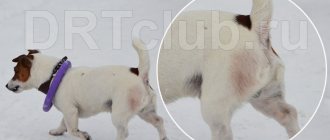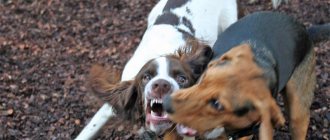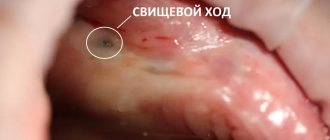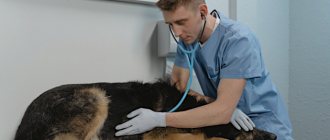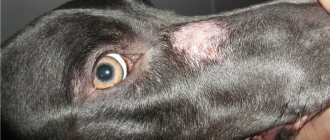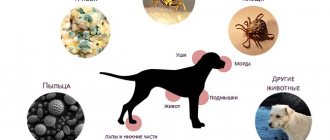Some dog owners do not think about the fact that their pet, like humans, has problems with teeth and gums, for example, they begin to become loose .
Toothache brings discomfort and a lot of trouble to four-legged friends and their owners. It is always easier to prevent a problem than to eliminate its consequences.
Main reasons
There is no smoke without fire. We suggest you understand the possible causes of loose teeth in dogs.
Changing dairy products to indigenous ones
When the puppy turns 3 months old, the period of teeth change begins. If at the age of about 3 months you notice that your pet’s teeth are loose, do not panic. The logical explanation here is that dairy products are replaced by permanent ones .
This process is explained by the fact that the rather long stone of the baby tooth is gradually crushed, weakened and pushed out by the growing tooth.
IMPORTANT! During this period, it is necessary to inspect the puppy's mouth daily.
What to do if a tooth that turns out to be a baby tooth is swaying? The owner can independently, with extreme care, loosen and pull it out using a sterile gauze pad.
However, when deviations from the norm are observed : the molars have already grown, but the milk teeth are still left, or the change of teeth has not yet begun at the indicated age, it is necessary to show the puppy to a specialist.
External manifestations
During this period, the puppy’s behavior changes noticeably: he begins to chew a lot, and, as a rule, everything in a row: things, furniture, shoes, bones, toys. This is how he tries to relieve pain and get rid of discomfort. In some cases added:
- general malaise;
- poor appetite;
- lethargy;
- disruptions in the digestive system;
- temperature increase.
Precautions
During the period of teeth change, the immunity of babies becomes not so strong. Therefore, provide the puppy with a calm regime: do not train him or walk him for a long time . Experts also do not recommend vaccinations. Take care of this in advance. To relieve discomfort, give your puppy a variety of toys that he can chew on and massage his gums.
Mechanical damage
A dog, by nature, is a very active and mobile animal. A loose tooth can be caused by mechanical damage after your pet chews on something excessively hard.
In this case, carefully examine the loose tooth for fractures or cracks . If any, immediately show your pet to a doctor to avoid complications.
Diseases
The causes of loose teeth in dogs can be various diseases .
Periodontitis
Inflammation of the tissues at the base of the teeth. This disease occurs most often. Periodontitis is manifested by the presence of plaque or tartar, and increased bleeding of the gums. The dog also develops bad breath and sticky saliva.
It is important not to put off treatment for too long, because... The bone tissue of the jaw may be damaged . This will lead to loosening of the teeth and their possible loss. Ultrasonic cleaning without anesthesia is used to remove tartar in dogs.
Periodontal disease
Inflammation of the surrounding tooth tissues, but the cause here will not be infection . Due to degenerative processes in the tissues of the gums and jawbone, the necks of the teeth become exposed, and the teeth appear longer. In later stages, they begin to wobble and fall out.
REFERENCE! This disease is quite rare; periodontal disease is often mistakenly called periodontitis.
Gingivitis
The first signs: stench from the mouth, redness and bleeding of the gums. Possible causes of inflammation in this case: tartar or bacteria (pathogenic microflora).
Individual characteristics
The most common problem among them is malocclusion. As a result, the tooth touches and injures the gum or the jaws cannot close completely. Just like in humans, bites in dogs can be corrected through the use of special structures and braces.
The appearance of tartar
As a rule, this process is characterized by the presence of a filmy, yellowish growth at the base of the teeth. It may have a brown, yellow or even greenish tint. In young dogs, these formations are initially soft and loose, but over time they harden, become denser and darken in color.
Outwardly, it looks like there are pieces of stone or chocolate in the dog’s mouth , because without timely intervention, almost nothing remains of the natural color of the teeth.
What causes it to form?
The main causes of this disease in dogs may be the following:
- Poor nutrition. Some pet lovers only feed their pets soft, canned food. Therefore, natural grinding of teeth does not occur, but a favorable environment is created for bacteria, which “produce” plaque.
- A complicating factor may be a congenital pathology of the location of the teeth : when they are crooked or grow too densely. Such situations are less common than the first, but they definitely require mandatory treatment.
Ignoring tartar in dogs leads to permanent inflammation of the gums, loosening and loss of teeth.
Prevention
No matter how paradoxical it may sound, dogs also need to brush their teeth . Of course, not twice a day, and not after every meal, but regularly. Periodically, you should go over your dog's teeth with a special brush with gel or clean with dental floss.
If you don’t have paste and brush at hand , you can make do with improvised means:
- Take a small piece of household gauze.
- Moisten with a weak solution of baking soda.
- Wrap it around your finger.
- Treat your dog's teeth.
also important to remember about proper nutrition for your four-legged pet. It is better to coordinate the diet with your veterinarian.
Treatment
Teeth cleaning should be performed by a veterinarian . Plaque is removed mechanically: it is simply scraped off and cleaned from the surface of the tooth. Stone removal is also performed using ultrasound.
What symptoms can you tell by?
The first signs of inflammation can be detected at home. If you feel pain or notice bloody discharge while eating or brushing your teeth, do not delay making an appointment with your dentist. Don't ignore:
- Redness, formation of white plaque on the gums.
- Swelling of the oral mucosa.
- Bleeding gums, metallic taste.
- Uneven height of the gingival margin, exposure of the necks of the teeth.
- The appearance of bad breath.
Splinting of anterior incisors
There are no particular differences in the reasons why front or back teeth become loose. But for incisors there is a special type of treatment - splinting . The procedure involves strengthening loose teeth to prevent them from falling out.
This fixation allows the gum tissue to recover and strengthen. Moreover, the main task of applying a splint is to redistribute the load due to fixed teeth . Once again we draw attention to the peculiarity - only incisors (front teeth) can be splinted.
IMPORTANT! Contact qualified specialists so as not to aggravate the situation and harm your pet.
Periodontitis
Periodontitis is a disease that is a consequence of gingivitis. In addition to gum inflammation, bone tissue becomes inflamed and tooth roots are destroyed. Teeth fall out, and in their place ulcers and fistulas can form. The danger of periodontitis is that the inflammatory process has gone so far that it can cause blood poisoning, which leads to death.
If you have periodontal disease, x-rays are taken to determine how damaged the roots are. Only after such a study can you decide which teeth can be left and which need to be removed so that sepsis does not form.
Treatment of periodontitis
It is impossible to do without removing the most damaged teeth. All deposits are removed from the rest. The gums are treated with an antiseptic. Antimicrobial drugs and antibiotics are prescribed.
Size and breed
The problem of tooth loss discussed in the context of this article is not uncommon. This phenomenon is especially common in such tiny breeds as the Yorkshire terrier, Chihuahua, toy terrier and others.
There are a number of reasons for this. First, tiny jaws have teeth that grow closer together than larger dogs. Secondly, small dogs live longer, so dental problems can arise not only due to poor care, but also due to age.
Why do gaps appear in the teeth?
Why does a dog's teeth fall out? The reasons are varied and can be divided into the following groups:
- genetic, inherited;
- resulting from severe metabolic disorders;
- acquired after injury.
Diseases in which there is a high risk of tooth loss
Most often this happens with highly developed tartar. It affects both the tooth itself and the gum that holds it. Damage to the gums turns into gingivitis, and if the course is negative, periodontitis occurs - tooth destruction.
The stone begins to form from the so-called biofilm. It consists of colonies of various bacteria, fungi, fusobacteria, and spirochetes. This is where the unpleasant smell comes from. It can lead to necrotic changes in the jaw. Gingivitis can also be caused by:
- malnutrition,
- acute microelementosis,
- immunosuppressive conditions,
- heavy metal poisoning,
- bite pathologies,
- nasal breathing disorder,
- diabetes.
Internal diseases leading to hair loss
These are all internal diseases that cause immune suppression, for example:
- rheumatoid arthritis,
- diabetes,
- osteoporosis.
Causes not related to disease
This should include:
- heavy metal poisoning,
- the effect of ionizing radiation,
- severe maxillofacial injuries.
Prevention
It is always easier to prevent a disease than to treat it. We offer several easy-to-follow recommendations.
- Remember that the first rule of healthy teeth and gums is regular cleaning . To do this, you can use a soda solution and gauze, special gel and toothbrush for dogs, and special hard treats. You can also visit your veterinarian regularly for professional cleaning.
- Watch your diet. The presence of solid textures is required: dry food, cartilage, small bones. It is also necessary to periodically allow special sticks and chewing toys to be chewed. Remember that the dog interacts with them through the oral cavity, so buy toys in trusted places: veterinary clinics and pet stores.
- giving your pet sugary treats
- If there are any manifestations of external symptoms of the diseases described, or pronounced formation of dental plaque or stones, immediately show your pet to a doctor .
Symptoms of loose teeth in dogs
- Unpleasant odor from the mouth
- Redness or bleeding along the gum line
- Excessive drooling, which may be tinged with blood, you may also notice bleeding when your dog plays with a chew toy or near a food or water bowl.
- Difficulty chewing, your dog may only chew on one side of his mouth or has difficulty lifting and holding food in his mouth.
— Swelling of the muzzle
- Loss of appetite
– Nasal discharge and/or sneezing
- Lumps or growths in the mouth
- Pain in the mouth
Consequences
Complete refusal of therapy can cause a number of serious complications. Bacteria that settle on stone or plaque begin to produce toxic substances. Together with saliva, waste products of microorganisms enter the gastrointestinal tract. This causes infectious diseases of the digestive system.
The resulting microflora gives rise to the development of dangerous infections in the mouth. The inflammatory process can spread to deeper tissues, right down to the skull. The dog has a risk of developing sepsis or osteomyelitis (purulent-necrotic inflammation of the bones).
With periodontitis of the 3rd (last) stage, complete removal of all the incisors of the animal is required. An advanced disease is characterized by the release of pus. Dwarf breeds older than 6-7 years are prone to periodontitis.
How to save loose teeth?
If your pet's teeth begin to loosen, especially the incisors, then you need to immediately contact a good specialist who will help preserve them. To do this, doctors use an effective method of teeth splinting, which is a dental procedure that allows you to strengthen loose teeth, prevent them from wobbling and subsequent unwanted loss.
Why you can’t install removable and bridge dentures against the background of advanced periodontitis
Loss of bone tissue and widening of the sockets during periodontitis create a very ambiguous situation: on the one hand, long-term conservative treatment in the later stages is rarely effective, on the other hand, prosthetics are also difficult, and the problem of missing teeth needs to be solved. However, not every treatment method is suitable.
Why are dental bridges not suitable?
Teeth with periodontitis are weakened and are on the verge of falling out; it is strictly forbidden to use them as support for a denture. The bridge will be movable along with the teeth on which it is attached. The risks are high, even if complex and long-term treatment was carried out before.
Why are removable dentures not suitable?
In fact, after a course of treatment for periodontitis (or closer to the middle of it after acute inflammation has resolved), removable dentures can be installed to solve the problem of partial absence of teeth. But only for a short time, because... When used long-term, they lead to many problems:
- do not stop bone atrophy, but only aggravate this process,
- put increased pressure on the gums and can provoke inflammation, which is extremely undesirable during the course of therapy,
- will require regular correction, since during treatment the damaged tissues are restored, which means the level of the bone with the gum will change - the dentures will no longer fit tightly, will shift, dangle,
- if teeth are partially missing, there is nothing to attach them to - as in the case of bridges, it is better not to use living teeth for support, especially if they are mobile,
- if the teeth are removed scatteredly, then removable dentures will not work at all; the minimum segment is 2-3 missing teeth in a row.
That is, removable dentures can provoke the development of periodontitis and negate all the results of a course of complex treatment. In addition, they are difficult to get used to - more than half of patients are not satisfied with them either in aesthetics or functionality.
Treatment
Oral injuries can vary in nature and severity. No matter how painful a tooth bruise seems, treatment must be carried out in a specialized dental clinic. We at Natadent often encounter such cases. After the initial diagnosis, visual examination, interviewing the patient and collecting anamnesis, an x-ray is taken - this is the only way to clearly determine which tissues are damaged and prescribe the correct treatment.
By studying an x-ray, the doctor can determine what kind of damage the tooth has received (this could be a fracture, dislocation, crack, various deformations and other pathologies).
Only after a correct diagnosis can treatment be prescribed. If a tooth injury has caused serious damage, electrodiagnostics is prescribed - a special procedure that allows you to determine the condition of the pulp, detect hemorrhages and necrotic areas in it. If diagnostic actions show that the damage is not very serious, a set of preventive measures is prescribed, which includes:
- application of compresses;
- use of decoctions for mouth rinsing;
- exclusion from the diet of hot dishes and foods that require chewing; exclusion of this area of the dentition from the chewing process by applying a bandage or protective splint.
- taking anti-inflammatory drugs.
If a more serious tooth injury is diagnosed, treatment may include surgery to the structure of the tooth and surrounding tissue. The sequence of actions is determined by the complexity of the injury, but in most cases includes the following steps:
- ;
- Local anesthesia is performed (or general if complex and painful treatment is involved).
- If the pulp sac is damaged, even if the tooth enamel has retained its structure, the doctor drills a hole in it and removes the nerve.
- The canals and cavity are cleaned, treated and filled, as in conventional caries treatment.
;
;
A tooth bruise is a dangerous injury that can lead to undesirable consequences and complications. Even if pulp removal and filling have been performed, it is advisable that the patient undergo a course of therapeutic treatment, and after some time come for additional examination. Only after this can it be said that the consequences of the injury have been completely eliminated and there will be no complications.



